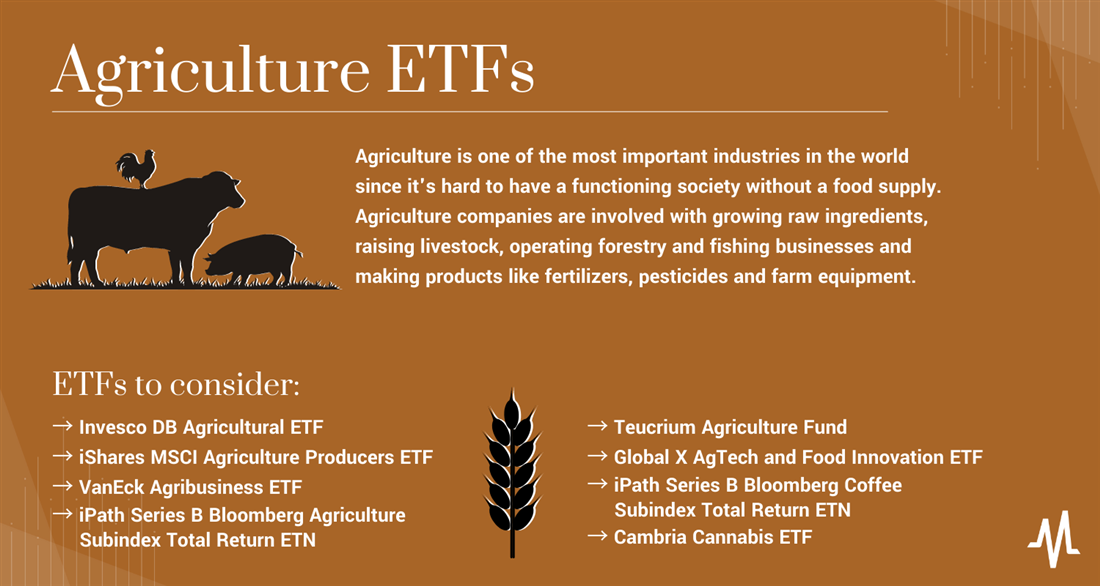Key Points
- Agriculture is a crucial industry but may not fit your portfolio.
- Agricultural ETFs either track food and farm companies or baskets of commodities through futures contracts.
- Agricultural ETFs often carry high expense rates and many have limited liquidity.
- 5 stocks we like better than Altria Group
ETFs make investing in a wide range of assets possible through a single security. These securities can be vast and span the entire market or narrow enough for just one sector or industry. Some sectors are more overlooked than others, and ETFs for agriculture are some of the more obscure securities in the market.
But are these ETFs worth a closer look? This article will discuss how agricultural ETFs work and list some options.
What are agriculture ETFs?
Agriculture ETFs allow you to invest in underlying assets related to the agriculture industry, like commodity futures, stocks of agricultural companies or agribusiness firms.
These ETFs are designed to provide you with a diversified portfolio of agricultural assets and a convenient way to get exposure to the sector without purchasing them all separately. The ETFs typically track specific indices composed of various agricultural assets.
Is there an agriculture ETF?
Yes, there are plenty. Agriculture is one of the most important industries in the world since it’s hard to have a functioning society without a food supply. Agriculture companies are involved with growing raw ingredients like wheat and sugar (as well as several non-food commodities), raising livestock like cows and pigs, operating forestry and fishing businesses and making products like fertilizers, pesticides and farm equipment.
The vast agriculture industry contains plenty of ETFs that have sprung up to provide exposure to the sector. These securities range from broad-based ETFs holding various agriculture stocks to narrow thematic funds based on a single commodity.
While there are fewer agriculture ETFs than banking or tech ETFs, investors looking for exposure will have plenty of options. But be prepared to pay up — agricultural ETFs are often small funds with limited liquidity and high expense rates.
Understanding agriculture ETFs
One type of ETF agriculture focuses on commodity futures. These ETFs invest in contracts representing the future delivery of agricultural commodities such as corn, soybeans or coffee. By investing in these futures, you can speculate on the price movements of these commodities without actually owning them physically.
Another type of agriculture ETF focuses on stocks of agribusiness firms. These ETFs invest in companies involved in farming, food processing, seed production, and equipment manufacturing. By investing in these stocks, you can gain exposure to the overall performance of the agriculture sector.
How to choose agriculture ETFs
What are the best agriculture ETFs? When considering which agriculture ETF to purchase, you must first decide what assets you want exposure to. You’ll find two different flavors of agricultural ETFs in your research: those that hold stocks connected to the agriculture industry, such as the iShares MSCI Agriculture Producers ETF NYSE: VEGI and those that track commodity prices like wheat or sugar, such as iPath Series B Bloomberg Agriculture Subindex Total Return ETN NYSE: JJA.
What’s the difference? ETFs with agricultural stocks will operate like traditional ETFs, but those based on commodities often have a different structure. As you’ll see in the list below, several funds are exchange-traded notes (ETNs). An ETN is issued by an investment bank, not an asset manager like BlackRock or Vanguard. Unlike ETFs, which hold assets like stocks, bonds or futures contracts, an ETN is an unsecured debt instrument that tracks a market index.
The price of the ETN rises and falls based on the performance of the underlying index. Created by Barclays Bank in 2006, ETNs aim to provide retail investors with tax-efficient exposure to complex securities like commodities or currency futures contracts. Think of them as the bond-like brother to equity-based ETFs — the index tracked may be similar, but the risks and rewards differ. Credit risk is a concern with ETNs since no assets are held, but tracking error is nonexistent, and there are no dividends or distributions to muddle up tax treatment.
8 best agriculture ETFs
What is the best agriculture ETF? The answer depends on your risk tolerance and preferred type of exposure. Here are eight different agriculture ETFs and ETNs that provide exposure to different areas of the sector.
Invesco DB Agriculture ETF
The first fund on our list, Invesco DB Agriculture ETF NYSE: DBA, is one of the oldest agriculture ETFs, but that doesn’t carry much weight in this sector. The Invesco DB Agriculture ETF was established in early 2007 and gives retail investors exposure to commodities through a balanced and highly liquid ETF.
DBA has just under $1 billion in assets under management and charges a net expense rate of 0.91%. The fund holds a variety of futures contracts on commodities like livestock, soybeans, corn, coffee and sugar, along with short-dated U.S. Treasuries. DBA holdings are convenient if you want commodities exposure and avoid trading futures.
iShares MSCI Agriculture Producers ETF
If commodities aren’t your ideal asset class, the next two ETFs might be more up your alley. First is the MSCI Agriculture Producers ETF from BlackRock’s iShares. The iShares MSCI Agriculture Producers ETF NYSE: VEGI holds many large-cap agriculture stocks in its portfolio, like Deere and Company NYSE: DE, Archer-Daniels-Midland Co. NYSE: ADM and Corteva Inc. NYSE: CTVA. VEGI isn’t a large ETF with just over $260 million in assets, but its 0.39% expense rate is cheap for an ag ETF and pays a small dividend. Over 56% of the fund’s holdings are U.S.-based companies.
VanEck Agribusiness ETF
The largest agriculture-related ETF is the VanEck Agribusiness ETF NYSE: MOO, with over $1.25 billion in assets under management. Despite being the largest by assets, MOO is less liquid than the similar-sized DBA and only sees about one-fifth of the share volume daily. But MOO has a reasonable 0.55% expense rate and pays a dividend yield of over 2%. The fund has more international holdings than VEGI (48% vs. 44%), including some large European companies like Bayer AG, Nutrien Ltd. and CNH Industrial NV. Some of the fund’s largest U.S. holdings include Tyson Foods Inc. NYSE: TSN and The Toro Co. NYSE: TTC.
iPath Series B Bloomberg Agriculture Subindex Total Return ETN
The first ETN on our list comes from Barclays’ iPath and tracks the Bloomberg Agriculture Subindex. The iPath Series B Bloomberg Agriculture Subindex Total Return ETN NYSE: JJA fund mimics this commodities basket’s price, currently weighing the heaviest soybeans, wheat, and corn. As an ETN, no dividends are paid, but the security does have a 0.45% expense rate, which is manageable for broad commodities exposure.
Teucrium Agriculture Fund
The Teucrium Agriculture Fund NYSE: TAGS is an investment firm focusing on agriculture-related securities. It offers exposure to a basket of commodities through four of the company’s smaller funds. TAGS has only $33 million in assets, but it’s a simple fund for investing in the price of wheat, corn, soybeans and sugar and carries a minuscule 0.13% expense rate.
Global X AgTech and Food Innovation ETF
One of the newest ag ETFs is the Global X AgTech and Food Innovation ETF NYSE: KROP, launched in 2021 by Global X. The fund is still small, with only $6 million in assets, but the expense rate is only 0.50%, and it offers exposure to smaller agriculture startups like Oatly Group AB NASDAQ: OTLY and Tattooed Chef Inc. NASDAQ: TTCF. Liquidity is a concern as only 2,400 shares are traded daily on average, and the dividend yield is just 0.71%. The fund offers diverse international exposure — only 42% of its holdings are American companies.
iPath Series B Bloomberg Coffee Subindex Total Return ETN
One of the offshoots of Barclays’ JJA fund, the iPath Series B Bloomberg Coffee Subindex Total Return ETN NYSE: JO fund narrows exposure down to just coffee futures. Tracking only the Bloomberg Coffee Subindex creates more volatility since coffee prices tend to gyrate wildly, especially during periods of economic uncertainty. JO carries the same 0.45% expense rate as its cousins. It’s also an ETN, so understand the risk and rewards of those products before investing.
Cambria Cannabis ETF
Now for a bit of an alternative agricultural ETF, Cambria Cannabis ETF BATS: TOKE. One of the largest-growing sectors is the cannabis industry as more and more U.S. states move to relax marijuana laws. The cannabis sector has been hit or miss over the last few years. The Cambria Cannabis ETF holds a variety of cannabis, tobacco and agriculture stocks like Scotts Miracle-Gro Company NYSE: SMG, Altria Group Inc. NYSE: MO and Jazz Pharmaceuticals PLC NASDAQ: JAZZ. The fund has just over $11 million in assets under management and carries a 0.42% expense ratio.
Pros and cons of investing in agriculture ETFs
Investing in agriculture ETFs has benefits and drawbacks. Before putting any capital to work in this sector, consider these points and how they may affect your investment goals.
Pros
The benefits of investing in agriculture ETFs include:
- Investing in commodities: Traders can invest in commodities through agricultural ETFs and ETNs. Commodity trading traditionally involves complicated futures contracts and requires a specific type of brokerage account. ETFs and ETNs are sold on major exchanges, and you won’t need margin to buy them.
- Under-covered sector: You won’t find Jim Cramer fielding too many questions on ag ETFs and stocks on his nightly Mad Money rounds. Some agriculture stocks like Deere and Company NYSE: DE are $100 billion market cap giants. Still, many others are small, under-the-radar companies like Arcadia Biosciences Inc. NASDAQ: RKDA or Intrepid Potash Inc. NYSE: IPI. While risky, small-cap ag stocks often slip through the cracks regarding analyst coverage and ratings.
Cons
The downside of investing in agriculture ETFs include:
- Expensive funds: One of the benefits of ETF investing is the ability to buy entire market sectors (or the market as a whole) through a single cheap fund. Unfortunately, many agricultural ETFs hold stocks and commodities contracts, which can lead to some pricey expense rates.
- No dividends: If you’re looking for high-dividend ETFs, you probably won’t find the agricultural sector appealing. Many funds are ETNs, debt securities that don’t pay dividends or distribute capital gains.
Factors influencing agriculture ETFs
Between geopolitical events, climate change and technological advancements, macroeconomic factors play a huge role in shaping investment decisions within the agriculture sector. They can have an impact on the performance of agriculture ETFs.
Geopolitical events can create volatility and uncertainty in the market. This includes political tensions, trade disputes or changes in government policies. These conflicts can disrupt supply chains, affect export/import dynamics and influence commodity prices. For instance, if one country imposes tariffs on wheat, its trading partners can sometimes retaliate, resulting in price fluctuations and market instability.
Climate change, too, especially when it causes extreme weather events like droughts, floods or hurricanes, can lead to crop failures, reduced yields and overall instability in the market. As climate change intensifies, consider the potential risks and opportunities it presents when considering the sector.
Finally, technological innovations like precision farming techniques, genetic engineering and automation can potentially revolutionize the agriculture industry. These advancements can improve crop yields, reduce costs, increase efficiency and ultimately impact the performance of agriculture ETFs.
Strategies for investing in agriculture ETFs
Timing is the number one consideration when you’re investing in agriculture ETFs. Here are some strategies to consider to maximize your investment potential:
- Research market cycles: Like any sector, agriculture experiences cycles of growth and decline. Understanding these cycles can help you time your investments. For example, agricultural stocks and commodities tend to perform well during high demand for crops, such as the planting and harvesting seasons.
- Diversify your portfolio: Agriculture ETFs offer exposure to various assets, including crop producers, seed and fertilizer manufacturers, agricultural machinery companies and even cannabis producers. By diversifying your portfolio across various subsectors within agriculture, you can capture different sources of potential growth and mitigate risk.
- Monitor geopolitical events: Stay informed about political developments, trade agreements and policies that can impact the agriculture industry. These can create opportunities or pose risks for agriculture ETFs. For example, a trade agreement that opens up new export markets for corn could benefit companies that grow or process it.
- Consider climate change risks: With increasingly serious climate-related events, assess the resilience of the agriculture companies in your portfolio. Look for companies that use sustainable farming practices, invest in climate adaptation technologies or develop drought-resistant crops. Stay updated on weather patterns and climate change projections to see how they might affect crop yields and commodity prices.
- Consider long-term trends: Look for long-term trends that can drive growth in the sector, like an exploding global population, changing dietary preferences and increasing demand for organic and sustainable food. You might see a rise in companies that practice organic farming, plant-based alternatives and environmentally friendly practices.
- Stay informed about technological advancements: Keep a close eye on developing technology. As precision farming techniques, genetic engineering and automation advance, they can significantly impact the performance of agriculture ETFs.
- Evaluate commodity prices: Monitor the prices of major crops such as corn and soybeans, as they drive the sector. Understanding the supply and demand dynamics can help you make informed decisions. Weather conditions, global demand and government policies can all influence commodity prices.
- Analyze financial performance: Take the time to assess the financial health of the companies included in the agriculture ETFs. Look at their revenue growth, profit margins, debt levels and overall stability. Strong financial companies are more likely to weather market fluctuations and provide consistent returns.
- Use technical analysis: Technical analysis means studying price patterns and market trends to predict future price movements. This can be useful for timing entry and exit points in agriculture ETFs. You can identify potential buying or selling opportunities by analyzing charts, indicators and patterns.
- Seek professional advice: If you’re unsure about navigating a farmland ETF’s complexities, consider consulting a financial advisor who specializes in the sector. They can provide expert insight and help you develop a tailored investment strategy based on your goals and risk tolerance.
Future trends in agriculture ETFs
As the agriculture sector evolves, a handful of emerging trends will likely shape the future of agriculture ETFs. They have to do with innovations, sustainable practices and technological advancements that can revolutionize the industry.
One prominent trend is the increasing focus on sustainable farming practices. With environmental conservation and climate change at the forefront of the global conversation, investors seek agriculture ETFs that use sustainable and eco-friendly growing methods. This includes precision farming techniques, which use data and technology to optimize crop production while minimizing resources. Those companies developing drought-resistant crops or investing in climate adaptation technologies are gaining traction, too. Agriculture ETFs can attract socially conscious investors and potentially outperform their peers in the long run.
Consumers seek more organic and sustainable food options as they become more health-conscious and environmentally aware. This shift presents an opportunity for agriculture ETFs to invest in companies specializing in organic farming methods and plant-based alternatives.
Technological advancements also play a crucial role in shaping the future of agriculture ETFs. Besides precision farming, genetic engineering and automation have already revolutionized the agriculture industry. These advancements may further improve crop yields, reduce costs and increase efficiency in the sector.
Crucial sector, but no slam dunk
Agriculture is one of the most necessary industries on the planet. But markets don’t always make sense, and just because an industry is essential for the species’ survival doesn’t make it an excellent investment.
Agricultural ETFs are often a mix of equities and commodities, meaning investors must understand two asset classes to navigate this sector successfully. Not only are these funds unlike most other sector ETFs, but they must also be expensive and illiquid, especially as the funds’ themes get narrower.
Always perform due diligence on these securities and understand how futures contracts work before investing in ag ETFs. To simplify your research, use the MarketBeat ETF screener to search for funds by market cap, expense rate or holdings.
FAQs
Still wondering what are the best agricultural ETFs? Here are a few commonly asked questions about agriculture stocks and how they fit into the broader market:
What is the largest agricultural ETF?
The largest agricultural ETF is the Invesco DB Agriculture ETF with over $900 million in assets under management.
What are the best ETFs to invest in farmland?
While there’s no specific farmland ETF per se, several ETFs invest in farmland stocks, such as the DB Agriculture ETF and the VanEck Agribusiness ETF.
What is the best agricultural stock to invest in?
When it comes to agricultural stocks, “best” is a very subjective term. Some investors will prefer food producers and farms, others may prefer companies that make farm equipment and pesticides. Or you could eschew equities altogether and focus on farming commodities like wheat, soybeans, livestock or grains.
Before you consider Altria Group, you’ll want to hear this.
MarketBeat keeps track of Wall Street’s top-rated and best performing research analysts and the stocks they recommend to their clients on a daily basis. MarketBeat has identified the five stocks that top analysts are quietly whispering to their clients to buy now before the broader market catches on… and Altria Group wasn’t on the list.
While Altria Group currently has a “Hold” rating among analysts, top-rated analysts believe these five stocks are better buys.
View The Five Stocks Here

Thinking about investing in Meta, Roblox, or Unity? Click the link to learn what streetwise investors need to know about the metaverse and public markets before making an investment.
Get This Free Report

